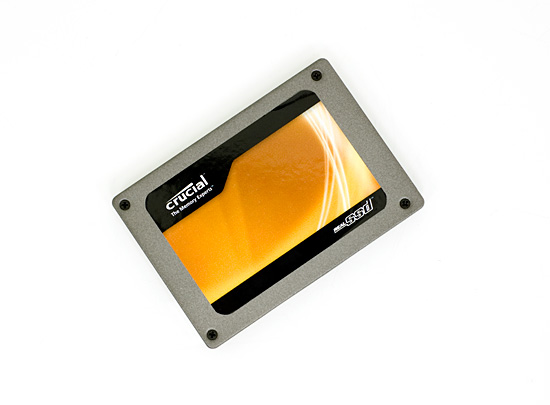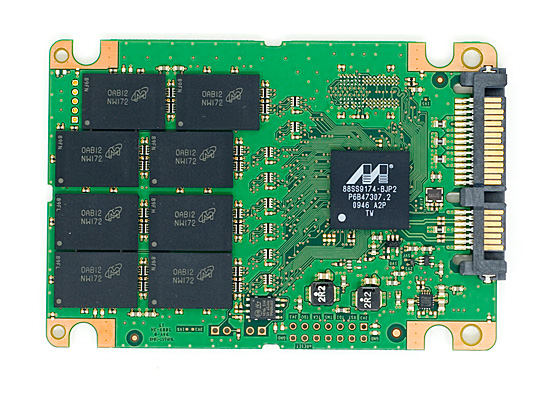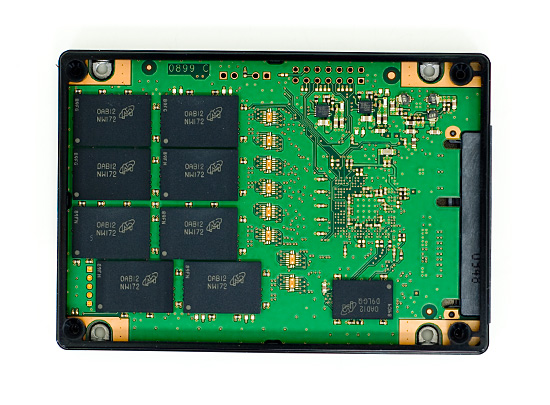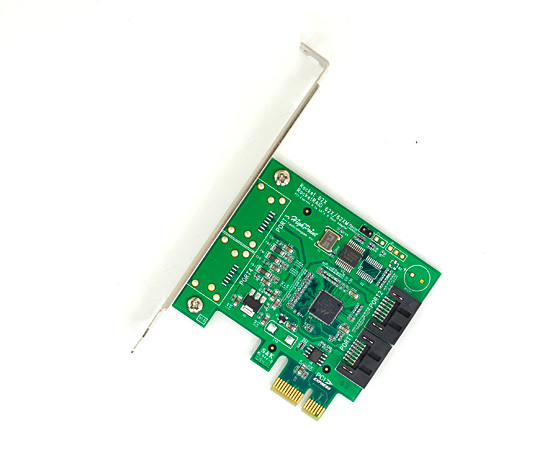OCZ’s Vertex Limited Edition Review & SSD State of the Union
by Anand Lal Shimpi on February 19, 2010 12:00 AM EST- Posted in
- Storage
Crucial/Micron RealSSD C300 - The Closest Competitor
While OCZ rushes to be the first to ship these superfast SSDs, Crucial and Micron will soon be shipping their RealSSD C300s. Based on a Marvell controller these drives (Crucial for the channel, Micron for OEMs) are far more traditional in their architecture.

Instead, the innovation comes from the use of ONFi 2.0 MLC NAND flash and a 6Gbps SATA interface. The combination of the two results in some extremely high sequential speeds. A seemingly well architected firmware (and a boatload of DRAM) work together to deliver good random access performance as well.


In testing the C300 it performed very much like a faster X25-M, there was one anomaly that bothered me: maximum write latency.
Like Intel’s X25-M, whenever the C300 goes to write data it also does a bit of cleaning/reorganization of its internal data. The more cleaning the drive has to do, the longer this write process will take. Micron did its best to minimize this overhead but eventually you’ll have to pay the piper. Below you’ll see the average IOPS, average MB/s, average and max write latencies for the C300, X25-M G2 and Vertex LE during my 4KB random write test:
| 4KB Random Write Performance | Average IOPS | Average MB/s | Average Latency | Max Latency |
| Crucial RealSSD C300 | 36159 IOPS | 141.3 MB/s | 0.0827 ms | 1277.9 ms |
| Intel X25-M G2 | 11773 IOPS | 46.0 MB/s | 0.255 ms | 282.9 ms |
| OCZ Vertex LE | 41523 IOPS | 162.2 MB/s | 0.072 ms | 109 ms |
While both Crucial and OCZ/SandForce offer incredible average write latencies, Crucial’s max latency is over a second! I haven’t actually seen max write latencies this bad since the JMicron days. But if you look at the average write latency, you’ll see that this max latency scenario basically never happens. I only worry about what happens when it does.
Crucial also warned me that despite the controller’s desire to keep performance as high as possible, if I keep bombarding it with random writes and never let up it may reach a point where it can no longer restore performance to an acceptable level. This sounds a lot like what Intel encountered with the original X25-M bug, although it’s not something I was able to bring about in normal usage thus far. Given the early nature of many of these drives, it’s going to take a lot of consistent use to figure out all of their quirks.
Overall performance of the C300 is excellent. Just like the Vertex LE, it performed admirably in all of our tests. Paired with a 6Gbps controller there’s actual a noticeable improvement in real world performance, although it’s limited to those scenarios where you’re doing a lot of sequential reads from the drive.

6Gbps SATA controller on a PCIe x1 card
The drive’s performance does come at a price. The RealSSD C300 will be available later this month in 128GB and 256GB configurations, priced at $499 and $799 respectively.










83 Comments
View All Comments
v12v12 - Tuesday, February 23, 2010 - link
"To calm your fears, OCZ is selling the Vertex LE with a 3 year warranty."Umm 3yrs is CRAP! It's the industry standard among ALL HDs... again, how many times do I have to catch Anand-staff soft-wrist-slapping these con-artist manufacturers?! Who's "assured" with a 3yr warranty vs what? I haven't seen any manu offering lower? So how's that a selling/assurance point... let alone if it's even VALID to list in this article?
What you should have said (if at all) was:
"To calm your fears, OCZ is selling the Vertex LE with a STANDARD 3 year warranty (just like everyone else)." Hahaha.
I just don't get how you can continue to soft-scold (more like a notation) these manufactures when you and I KNOW it's crap. Well Okay I DO know; you're smart and running a business/review site (pro-business) and you don't wanna bad mouth these guys like you OUGHT to do. So instead you'll give them wrist slaps at the end of all the journalist-sensationalism in order to wash over the apparent chicanery of these businesses, so they'll keep sending you beta/new samples... Yes I know how the POLITICS of "business" works these days; sucks for the avg-minded consumer who totally misses keystone issues like this for all the hype and grandeur laced commentary... Sigh, the consumer-cattle loses again.
OWC Grant - Tuesday, February 23, 2010 - link
FWIW to this discussion thread and wasn't covered in the brief mention, the OWC Extreme Enterprise comes with an enterprise class level warranty...FIVE years. So, based on pricing and other similarities, will leave it up others to decide what the best value/performance ratio is in SSDs.kunedog - Tuesday, February 23, 2010 - link
Let's also not forget that he *never* acknowledged the near-immediately stratospheric pricing of Intel's G2 X-25M, right after he praised its affordability:http://www.anandtech.com/storage/showdoc.aspx?i=36...">http://www.anandtech.com/storage/showdoc.aspx?i=36...
He mentioned the firmware problems and lack of stock once but never the pricing.
ONLY now, over 6 months later, do we see prices anywhere near what he predicted at release:
80GB for $220
http://www.newegg.com/Product/Product.aspx?Item=N8...">http://www.newegg.com/Product/Product.aspx?Item=N8...
160GB for $430
http://www.newegg.com/Product/Product.aspx?Item=N8...">http://www.newegg.com/Product/Product.aspx?Item=N8...
The 160GB comes with a free Apricorn USB enclosure, the same one "randomly plugged" here by Anand. It's a strange coincidence to see two sites decide to associate it with SSDs (why would you put an SSD in an USB enclosure?).
shin0bi272 - Monday, February 22, 2010 - link
I thought I saw a review on anandtech a few months ago about the corsair p128 which was supposed to be a great ssd. But its not included on these benchmarks. Its supposed to have 220mb seq read and 200mb seq write. yet its not included? why?OWC Grant - Monday, February 22, 2010 - link
Glad to see so much interest in SSD!As Anand was made aware, our earliest units went out to reviewers and we contacted him and other reviewers to get these units back upon learning of a firmware revision that became available early Feb. In direct communication with him, he noted that neither firmware version had any effect on the performance.
All other OWC SSD units in the field (and available with same day to 1 day delay shipping from OWC) do have the latest firmware revision.
So, we are not "a bit behind OCZ" in this regard.
Hope this clears up the matter...and that you get an OWC SSD for yourself!
smith11 - Monday, February 22, 2010 - link
There's something that I'm not getting...If there's 0.5x write amplification because of real-time compression, why wouldn't the effective capacity be a good bit higher than (the non-reserved part of) the physical capacity ???
GullLars - Monday, February 22, 2010 - link
When i was reading this test, i couldn't help but think on several occasions that a cheap RAID of 3-4 intel x25-V from ICH10R would beat many of the drives tested here, and at a lower price.4 x25-V in RAID 0 gives 160GB capasity, roughly 600 MB/s seq read (limited by ICH10Rs bandwidth), about 140-150 MB/s seq write, around 100.000 4KB random read IOPS (400MB/s) at higher queue depths, and about 40.000 4KB random write IOPS (120MB/s). At a price point around $400-450, wich is about the same as Intel x25-M G2 160GB costs...
I think it would be great if Anand could do a test with 4 x25-V in RAID 0 from ICH10R to demonstrate a budget concious enthusiast setup.
semo - Monday, February 22, 2010 - link
Hi Anand,Great article. Any word on PCI-e SSDs? Are you leaving them out because of high costs or other reasons?
Also, good to know that you have our backs if those SSDs start crapping out. Without people like you companies get away with it for a long time.
rubbertoe - Sunday, February 21, 2010 - link
Looks like Amazon is also selling the 100G version:http://www.amazon.com/gp/product/B0035RQZSG/ref=pd...">http://www.amazon.com/gp/product/B0035R...X0DER&am...
Can someone confirm this is the drive that was reviewed? With selling only 5,000 does anyone have any idea how they will be distributed into the retail channels?
RT
neoflux - Sunday, February 21, 2010 - link
The OCZ Agility uses Intel 50nm or Toshiba 40nm flash.The OCZ Solid 2 uses Intel 34nm flash.
The OCZ Vertex uses Samsung flash, but what SIZE?
And based on that size, if the controller is the same as Anand mentioned a few articles ago, is the Solid 2 faster or at least the same speed-wise as the Vertex?
I did find that the Solid 2 may actually have some sort of 'crippled' Indilux controller, but that was just some forum, not an article.
I have gone back through all the Anand articles and googled everything I could think, but could not find the answer.
Someone enlighten me as to the size of the flash and the speed compared to the Vertex?